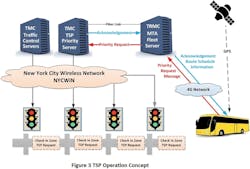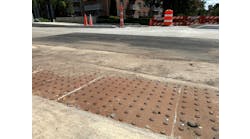Every day nearly 6,000 New York City transit buses navigate through some of the world’s busiest streets controlled by over 12,800 traffic signals.
With congestion only increasing on arterials and local streets, and no room for road expansion, the New York City Department of Transportation (NYCDOT) needed a way to improve the travel time reliability of public transportation and keep city streets moving.
NYCDOT began looking into solutions about 15 years ago, analyzing the impact on sample arterial systems using local transit-signal priority (TSP) to modify the intersection timing and provide preferential treatment for transit vehicles. The intent was to keep city buses on schedule and reduce overall travel times. The TSP program was officially launched in 2008 with several pilot projects. The traffic-signal controller firmware was modified so it could adjust the existing signal timing, either by extending a green time or reducing the red time by shortening the opposing green. Travel times improved 15% to 23%, but this local TSP deployment approach required procurement and installation of costly equipment at each intersection. In fact, the TSP support equipment was more expensive to deploy than the complete traffic controller itself; this type of
cost model proved impractical for citywide deployment.
Tech marches on
While some today might argue that Moore’s law on the doubling of technology every two years may have reached its saturation point, advances in wireless networks and traffic-control systems opened the door for more practical solutions.
Starting back in 2003, NYCDOT began installing advanced traffic controllers (ATC) to replace the electromechanical technology of the 1950s. (The controllers were based on the evolving advanced transportation controller standards program, funded under a joint memorandum of understanding with AASHTO, ITE, and NEMA.) The ATCs included provisions to support TSP operation and were used for the local TSP trials described above. In 2007, the NYC Department of Information Technology and Telecommunications (DoITT) began installing a citywide, city-owned wireless network, NYCWiN, which provided ubiquitous high-speed communications to all of the city’s traffic controllers, in addition to supporting a variety of other city services. At the same time, NYCDOT upgraded its central system to TransCore’s TransSuite traffic-control system.
With these advances in place, in 2011, TransCore, NYCDOT and New York City Transit (NYCT) launched a joint effort to develop an alternative approach to TSP. Working closely with NYCT, the advanced electronic systems already being installed in the newer transit vehicles were upgraded with advanced global positioning system (GPS) technology and additional software that could monitor the location of the buses and transmit TSP requests to the NYCT Transit Management Center (TRMC). These requests were then forwarded on to the NYCDOT Traffic Management Center (TMC), which evaluated the request and transmitted the TSP requests to the intersection traffic controller using the wireless network, as depicted in Figure 1.
By adding software to the in-vehicle systems and using the wireless networks and traffic-control software, TSP could now be deployed anywhere without costly intersection-based infrastructure, saving thousands of dollars per intersection and making universal deployment feasible throughout New York City.
Figure 1. TSP operation concept for the NYCDOT/NYCT program.
In 2012, NYCDOT implemented the new, central TSP pilot program that leveraged these new technologies. The system was first rolled out on the Manhattan M-15 Select bus service on 2.43 miles of roadway in lower Manhattan, a path describing Water Street that was considered to be representative of the challenges to deployment including urban canyons, wireless “dead zones,” turning movements, and a combination of two-way and one-way streets. (This corridor is depicted in Figure 2.) Using in-vehicle technology, the ATC, the new traffic-control system, and the wireless infrastructure, New York City is estimating to save more than $25 million in capital expenditures alone for the local TSP devices to support TSP operation at its 12,800 intersections.
In a New York second
The in-vehicle system monitors the bus location and issues the TSP request when the vehicle reaches the configured trigger point. The TSP request is event-driven and is transmitted to the TRMC, which tracks the vehicle’s progress, and forwards the request to the TMC, where it is evaluated and forwarded to the intersection using a modified National Transportation Communications for ITS Protocol (NTCIP) block object. The intersection then modifies its signal timing to “help” the bus through the network.
The entire process from initial request to receipt by the traffic controller takes less than 1 second. Should the vehicle be delayed in reaching the intersection, it can send a TSP update request to extend the time to arrive by adjusting timing during the next cycle, as well. Once the vehicle exits the intersection, it transmits a TSP clear, notifying the intersection that its TSP actions are no longer required.
This new central TSP system also provides real-time operations data so traffic-management operators can monitor the system operation and “fine tune” the trigger points as necessary. Data logging occurs at the vehicle, the TRMC and the TMC and is used for offline analysis to allow improvements in system operation.
Ops verification
To provide the data for analysis, the TSP operation and bus operation information was captured in a series of event logs stored in the vehicle, at the TRMC and at the TMC. This included GPS location information, and signal timing and operation information. To measure the “before” and “after” operation, the system was randomly enabled and disabled for various days over a four-week period. The data was then subjected to both qualitative and quantitative analysis.
The location of the TSP requests were plotted for the approaches to verify the GPS accuracy, and the signal timing of the traffic controllers was captured with a timing logger (part of the traffic-control system) that showed when the traffic controller received the request and the clear messages, as well as the amount of the actual timing changes performed at the intersections. The bus logs provided information on the communications reliability and timing to confirm latency of the various communications media.
Three types of the TSP operation were verified by analysis of the logs:
1. The vehicle was able to get through the intersection without changing the timing;
2. The signal extended the green time allowing the bus to get through the intersection; and
3. The side street (conflicting) green time was shortened to provide an early green time.
In all instances, the time added to the approach green was subtracted from the side-street green time to maintain the progression on the main street. It should be noted that with short cycle times (typically 90 seconds) used in Manhattan, and allowances for pedestrian time and clearance, the actual time that the green time could be modified was relatively short, yet the results, even with minimal changes, proved valuable. In a few instances, it took more than one cycle to get the bus through the intersection, largely during peak periods; in these instances, the side street would again be shortened to provide preference to the main street to assist the bus. Note that the actual parameters for managing the TSP operation are configurable within the traffic controller and include phase insertion (protected left/right) and queue jump (for near side stops), as well as the traditional extension of the main street and contraction of the side street.
It takes a team
The central TSP pilot program was part of the overall regional ITS architecture and was developed following the systems engineering process. A project system engineering analysis report was prepared and reviewed by the Federal Highway Administration, the Federal Transit Administration and New York State Department of Transportation. NYCDOT and NYCT are the two primary partners and sponsors of the city’s TSP program. The team members also included DoITT, which owns and operates the city’s wireless network; Greenman-Pedersen, which developed the simulation models to establish the trigger points and signal timing; Global Traffic Technologies, which provided the TSP application on the buses; Peek Traffic, which provided the advanced traffic controllers; and TransCore, which designed the TSP system, provided the TSP central sever and software, and integrated and tested the traffic-management components. This team is continuing the ongoing deployment for additional transit corridors.
Figure 2. The lower Manhattan TSP pilot project was deployed on the M-15 Select route.
Resulting in . . .
As noted above, the TSP operation was randomly enabled and disabled over a four-week period to evaluate the efficacy of the operation. The study shows improvements in the average bus travel time and the average travel speed comparing the “with TSP” and “without TSP” conditions, even after optimizing the signal timing. The system showed improvements greater than 18% for the northbound direction and more than 14% in the southbound direction.
For improving travel times and keeping city buses on schedule, ITS-NY recognized the NYC TSP pilot program with an Outstanding Project of the Year award. Moreover, the project recevied the Diamond Award from the American Council of Engineering Cos. (ACEC) in 2014 for the implementation of TSP in Lower Manhattan.
Based on the results to date, NYCDOT and NYCT are proceeding with the deployment of the central directed TSP as a cost-effective mechanism to extend TSP throughout the city. Ultimately, NYCT will outfit all 5,700 MTA buses operating over 2,800 miles of service routes citywide. This successful pilot program provides additional options to NYCDOT to implement more TSP corridors without investing scarce funds in unnecessary infrastructure. TSP operations can be configured and enabled at any intersection by any operator at the traffic management center through the TransSuite system which configures, controls and monitors all 12,800 traffic-signal controllers. TM&E



